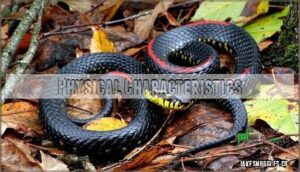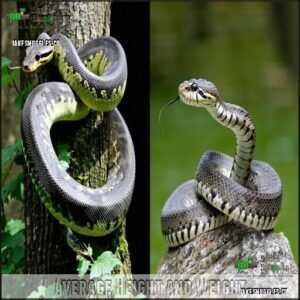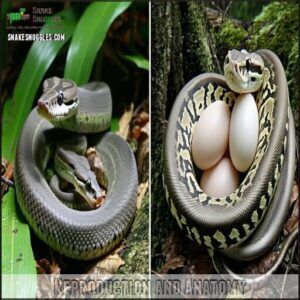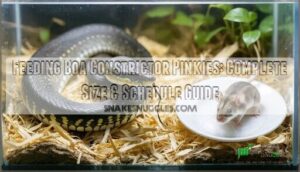This site is supported by our readers. We may earn a commission, at no cost to you, if you purchase through links.
 The main difference between pythons and boas lies in reproduction and anatomy. Pythons lay eggs (oviparous), while boas give birth to live young (ovoviviparous).
The main difference between pythons and boas lies in reproduction and anatomy. Pythons lay eggs (oviparous), while boas give birth to live young (ovoviviparous).
Pythons also have extra bones in their skulls and more teeth—talk about a strong bite!
You’ll often find pythons in Africa and Asia, but boas stick mostly to the Americas.
Both snakes are constrictors, though boas tend to be slightly smaller. If you’re picturing a giant snake hanging out in a tree, it’s likely a boa, while pythons prefer ground-level prowling.
Curious how they’ve adapted to their environments? There’s more to their story than meets the eye!
Table Of Contents
- Key Takeaways
- Physical Characteristics
- Habitat and Distribution
- Behavior and Temperament
- Reproduction and Anatomy
- Care and Lifespan
- Frequently Asked Questions (FAQs)
- Are boa constrictors a Python?
- What is the difference between a Python and a boa?
- Do pythons and boa snakes have the same teeth?
- Are pythons more defensive than Boas?
- How can you tell a Python from a boa?
- What are the unique characteristics of pythons and Boas?
- Which is more aggressive, Python or Boa constrictor?
- Are pythons part of the boa family?
- How do you tell if a snake is a boa?
- How do pythons differ from boas reproductively?
- Conclusion
Key Takeaways
- Pythons lay eggs, while boas give birth to live young—reproduction is a major difference.
- Pythons are generally larger and prefer staying on the ground, while boas are smaller and love climbing trees.
- Pythons live in Africa, Asia, and Australia, but boas stick to the Americas.
- Pythons have more teeth and unique head pits for sensing heat, unlike boas.
Physical Characteristics
You’ll notice distinct differences in the physical appearance of pythons and boas as you compare their coloration, patterns, and size.
Pythons display diverse patterns ranging from deep brown to gold with various stripe combinations.
Boas typically show brown or tan markings that increase in size toward their often reddish tails.
Color Patterns and Markings
When distinguishing between pythons and boas, their color patterns and markings offer vital visual clues.
You’ll notice these fascinating differences:
- Boas typically showcase brown to tan shades with reddish markings that increase in size toward their tail
- Pythons display diverse patterns including deep brown, gold, and combinations of red, black, and white
- Both snakes use their unique color variations for camouflage in their natural habitats
- These adaptations often involve desert color patterns that aid in predator evasion and prey capture.
These physical differences help experts identify each species, though similarities can make identification challenging, and understanding natural habitats is crucial for this process, involving camouflage and predator evasion.
Head Shapes and Sizes
While color patterns can be similar, the head shapes of pythons and boas offer clearer identification clues.
You’ll notice subtle differences in skull structure and facial features that experts use to tell them apart.
| Feature | Python | Boa |
|---|---|---|
| Head Shape | More triangular | More oval |
| Scale Patterns | Heat-sensing pits | No heat pits |
| Jaw Alignment | Wider gape | Narrower gape |
The python’s head morphology includes specialized heat-sensing pits that boas lack, giving them an advantage when hunting in darkness with their wider gape and more triangular head shape.
Average Height and Weight
Between these two giants, pythons typically outgrow boas in the size department.
You’ll find pythons ranging from 3 to a staggering 33 feet long, while boas usually top out between 6 to 13 feet.
Weight variations are significant too—boas typically weigh 45-100 pounds, but the green anaconda (a boa species) can reach over 500 pounds.
Meanwhile, ball pythons are much smaller, with males weighing just 3-4 pounds.
Understanding the size comparison details is essential for snake enthusiasts to appreciate these species, and recognize the importance of size comparison.
Habitat and Distribution
You’ll find boas mainly in the Americas where they often hang out in trees.
Pythons make their homes across Africa, Asia, and Australia in various environments from forests to deserts.
These two snake families have distinct geographical boundaries that never overlap in the wild, making their native distribution one of the easiest ways to tell them apart.
Geographical Locations
While you might encounter pythons across Africa, Asia, and Australia, you’ll find boas primarily in the Americas.
Native regions for pythons include diverse continental distributions from the savannas of Africa to the jungles of Southeast Asia.
Boa constrictors have established their geographical origins throughout Central and South America, with particularly strong presence in tropical rainforests.
You’ll never spot a wild python in South America – that’s strictly boa territory.
Understanding snake species basics is essential for their care and conservation of these species, and recognizing the difference is crucial for wildlife enthusiasts.
Environmental Preferences
When exploring python habitat versus boa constrictor environments, you’ll notice distinct preferences.
Boas thrive in humid tropical climates with high humidity levels, often near water sources.
Pythons adapt to diverse climate zones from lush rainforests to arid deserts, showing remarkable versatility across terrain types.
While both snakes require specific temperature ranges, pythons tolerate more varied sun exposure and environmental conditions than their boa counterparts, which includes high humidity levels and diverse climate zones.
Arboreal and Terrestrial Habits
If you thought snakes stick to the ground, think again! Boas love arboreal life, often climbing trees, while pythons prefer ground-dwelling but adapt well to water.
Here’s what defines their terrain preference:
- Boas favor trees for hunting.
- Pythons excel at water adaptation.
- Boas thrive in rainforest snake habitats.
- Pythons explore diverse terrains.
- Pythons dominate terrestrial habits.
Understanding tree dwelling snakes is essential for grasping their habitat preferences.
Behavior and Temperament
In terms of behavior, boas tend to be more defensive while pythons are typically less confrontational. You’ll also notice boas are often more active and curious, especially in captivity.
Defensive Mechanisms
Boa constrictors rely on threat displays, hissing loudly and striking defensively when cornered, while pythons generally avoid confrontation, fleeing tactics being their first choice.
Both constrictor snakes use camouflage to blend into surroundings, avoiding danger entirely.
Snake behavior shifts under stress; even the calmest python may adopt attack postures. This shows how defensive mechanisms vary between these fascinating species.
Activity Levels and Curiosity
Pythons and boas showcase distinct exploration behavior and movement habits.
Pythons prefer calm, deliberate movements, while boas are curious and actively explore their surroundings with bold investigative behavior.
Boas are curiosity-driven, often actively slithering to investigate their surroundings, especially when provided with environmental stimulation.
Meanwhile, pythons exhibit calmer activity patterns, preferring subtle movements unless disturbed.
These snake personalities highlight fascinating contrasts:
- Boas: More active explorers.
- Pythons: Typically laid-back.
- Activity depends on habitat setup.
- Both thrive with enrichment activities.
Diet and Feeding Habits
In terms of diet, both pythons and boas are skilled constrictors, relying on Hunting Tactics to secure prey.
A snake species diet varies depending on several factors.
Python feeding involves larger meals, like hefty mammals, while boa feeding leans toward smaller animals. Feeding Frequency varies too—pythons eat every 5–21 days, while boas stretch it to 4–8 weeks.
Both snakes excel at Food Digestion, meeting their Nutrient Requirements effectively.
Reproduction and Anatomy
In the context of reproduction, boas give birth to live young, while pythons lay eggs that require external incubation.
Their anatomy also sets them apart, as pythons have more teeth and distinct skull structures compared to boas.
Ovoviviparous Vs Oviparous
In the context of reproduction, boas and pythons truly separate themselves.
Boas are ovoviviparous, giving live birth, with embryos developing inside the mother. Meanwhile, pythons are oviparous, laying eggs that require external incubation.
Here’s the breakdown:
- Boas: live-bearing.
- Pythons: egg-laying champions.
- Embryo development: internal for boas, external for pythons.
- Reproductive strategies: wildly different.
- Live birth vs egg laying: a defining feature!
Skull Bones and Teeth
Snake anatomy reveals a clear python-boas difference.
Pythons have more skull bones and teeth, including a premaxilla bone with upper jaw teeth, giving them the edge in tooth count.
Boa skulls lack this bone, making their tooth shape less numerous but still effective for constrictors.
These adaptations help each thrive in their habitats with specialized feeding mechanics, using their unique traits to thrive.
Jaw Structure and Constriction
Moving from skulls to constriction, boa constrictors and pythons show fascinating snake anatomy.
Their jaw bones are highly flexible, helping them swallow prey whole. Muscle anatomy plays a big role too, delivering the crushing force needed to subdue prey.
Though similar, their constriction methods differ slightly, showcasing unique python characteristics and tooth structure adapted for gripping and holding struggling prey effectively.
The unique snake jaw structure is a key factor in their ability to eat large prey due to their snake jaw mechanics, which highlights the importance of flexible jaw bones.
Care and Lifespan
Caring for pythons and boas means meeting their specific needs for exercise, diet, and a properly maintained enclosure.
With the right care, both species can live over 30 years, making them long-term companions.
Exercise and Stimulation
Snake health relies on proper exercise routines. Both pythons and boas benefit from short, weekly sessions of physical activity and mental stimulation.
Simple activities like gentle snake handling or environmental enrichment, such as sensory play with new textures or climbing opportunities, mimic their natural behaviors.
Understanding boa characteristics versus python characteristics helps you create customized snake exercise plans for happier, healthier pets. Captive ball pythons can live exceptionally long lives.
Captive ball pythons thrive with love and care, living long, content lives that often exceed30 years in age.
Health and Hygiene
Good health starts with proper care.
Watch for signs of issues like shedding problems or respiratory infections—these can sneak up on even the healthiest snake.
Stay sharp with these tips:
- Parasite control guarantees smooth scales and a happy python.
- Avoid thermal burns by monitoring enclosure heaters.
- Handle rodents properly to prevent diseases impacting snake diet and digestion.
Regular snake health product checks are essential for maintaining peak health.
Enclosure Requirements and Size
Proper enclosure size is a must for a healthy python or boa.
Adult boas need 6’L x 3’W tanks, while larger python species might surpass 10 feet.
Maintain temperature control at 78°F–95°F and humidity levels around 60–70%.
Use substrates like bark or carpet, add hiding spots, and make certain ventilation systems mimic their natural habitat.
Researchers study python enclosure tank systems to improve snake care.
Frequently Asked Questions (FAQs)
Are boa constrictors a Python?
Imagine unraveling a biological puzzle—boa constrictors aren’t pythons.
They belong to separate families: Boidae (boas) and Pythonidae (pythons).
Unlike pythons, boas give live birth and thrive in distinct habitats across North and South America.
What is the difference between a Python and a boa?
Pythons lay eggs; boas give live birth.
Pythons usually grow larger, while boas stay smaller.
Pythons thrive in Asia, Africa, and Australia, but boas stick to the Americas.
Their patterns and behaviors also differ slightly.
Do pythons and boa snakes have the same teeth?
No, they don’t.
Python teeth are more numerous, built for gripping larger prey, while boas have fewer teeth.
Python skulls also incorporate premaxilla bones, a feature boas lack, adding structural differences between their jaws.
Are pythons more defensive than Boas?
Pythons tend to avoid confrontation, showing less defensive behavior than boas.
They’re a bit quicker to react, while pythons often stay calm unless provoked or threatened.
Boas, especially unfamiliar with humans, act more defensively.
How can you tell a Python from a boa?
You can spot differences by their size, patterns, and reproduction.
Pythons lay eggs, boas give live birth.
Pythons are often larger, with varied patterns, while boas are smaller, favoring browns and reds, and this distinction can be seen in their size.
What are the unique characteristics of pythons and Boas?
Boas birth live young, while pythons lay eggs.
Pythons often grow larger, showcasing diverse patterns like stripes or diamonds.
Boas prefer climbing trees; pythons stay grounded.
Their striking traits make them fascinating yet hard to identify.
Which is more aggressive, Python or Boa constrictor?
Boa constrictors are generally more defensive, especially when unfamiliar with humans.
While pythons tend to avoid confrontation, aggression can vary by species and situation, so handling either with care is always wise.
Are pythons part of the boa family?
No, pythons aren’t part of the boa family.
They belong to separate families—boas are in Boidae, while pythons fall under Pythonidae.
Despite similarities, their reproductive methods and specific anatomy highlight their distinct evolutionary paths.
How do you tell if a snake is a boa?
Seeing a boa involves noticing its reddish-brown markings, a preference for climbing trees, and its live-birthing nature.
Unlike egg-laying pythons, boas give birth to live young, often thriving in tropical, humid environments.
How do pythons differ from boas reproductively?
You can tell them apart by how they reproduce.
One delivers live young (viviparous), while the other lays eggs (oviparous).
In short, it’s live births versus egg incubation—it’s like nature’s own parenting debate!
Conclusion
There’s a universe of difference between pythons and boas.
From their unique reproduction methods—eggs for pythons, live young for boas—to their habitats and behaviors, these snakes reveal fascinating adaptations.
Pythons dominate Africa and Asia, sticking to the ground, while boas thrive in the Americas and love tree life.
Their anatomy and habits make them masters of constriction, with distinct skulls and hunting styles.
Dive deeper, and you’ll see just how remarkable these reptiles truly are, with fascinating adaptations.
- https://www.reddit.com/r/snakes/comments/6yrrdf/boas_vs_pythons/
- https://a-z-animals.com/animals/comparison/boa-vs-python-how-to-tell-them-apart/
- https://snake-facts.weebly.com/boa-vs-python-difference.html
- https://www.worldatlas.com/articles/what-are-the-differences-between-a-boa-and-a-python.html
- https://petkeen.com/are-anacondas-poisonous/















